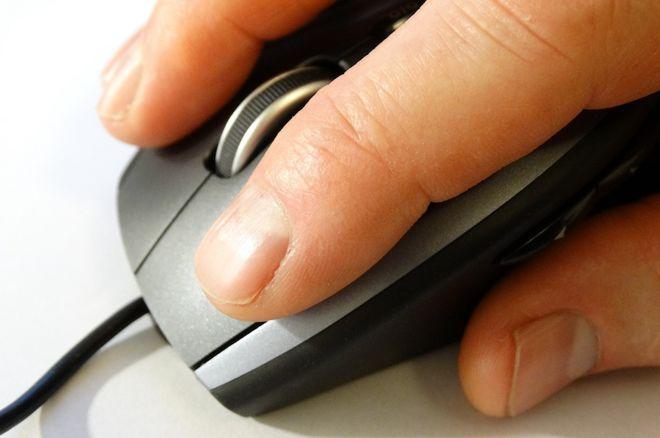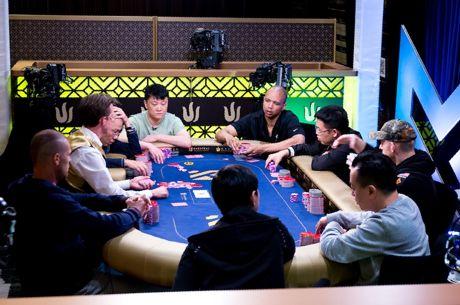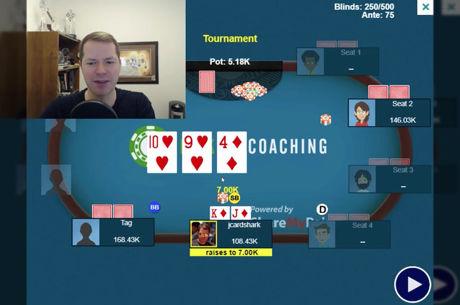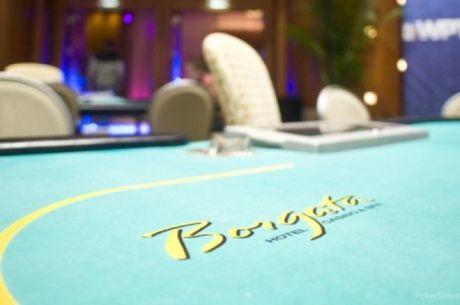A Lesson in Hand Reading; or, But What Is Going to Call?

"But what is going to call?" is a crucial question most recreational players, and indeed some grizzled professionals, never get around to asking themselves before making a bet or raise. At least they don't ask themselves this question often enough �� especially when it costs the most.
Here's a hand of six-handed online poker played at the 100NL stakes ($0.50/$1) in the "Zoom" format on PokerStars that illustrates an example of a player making this very mistake.
A Slow Start
There are three principal characters in this hand �� the everyman in the cutoff, the grinder on the button, and the gambler in the small blind.
The everyman in the cutoff started things with a raise to $3 from his $110 stack. The grinder on the button had $144 to begin and three-bet to $9. Then the gambler in the small blind with only $77 to start made a hopeful cold-call of the reraise.
The cutoff called, too, and the flop came Q?10?3?. Then, there was no action. Nothing exciting happened. Checks all around.
The turn brought the seemingly innocuous 6?. Again, checks all around.
Hand Reading Doesn't Stop
Poker takes concentration. Often in small and medium pots, particularly when they occur in the middle of long sessions or online sessions involving many tables, most humans are liable to let their guard down once in a while and click that mouse when perhaps they should not.
But hand reading doesn't stop simply because money isn't going into the pot. In fact, the players all clicking "check" on these first two postflop streets is very telling, since that allows everyone to eliminate from players' ranges those hands that, simply stated, would have bet. Indeed, you'll often find many Zoom players sleepwalking through such pots.
In this hand the two checks mean we can eliminate from the button's range both strong hands and top pair, no kicker. With strong hands he would have bet the flop or the turn, and with top pair he would have bet this turn quite often after the flop had checked through then both opponents checked to him again.
For our everyman in the cutoff, we also have to eliminate basically all strong hands. Had he turned a set of sixes, let's say, he would have bet. Had the cutoff flopped top pair, he would have bet this turn.
But consider even draws or hands like KxJx or 8?7? are unlikely to be in the cutoff's range once he checks this turn. Ace-high draws like AxJx and even the nut-flush draw could win at showdown after all, but KxJx or 8?7? is going to find the turn a tempting semi-bluffing spot.
What about our cold-caller in the small blind (the gambler)? On paper his hand might look like pocket jacks, but in reality, looking at his stack size, we can guess that his preflop range, and consequently, his range to check both the flop and turn, is much much wider and more diverse than that.
Many players who are trying their luck in the Zoom games these days will cold-call three-bets with any pocket pair, hoping for a big scoop. At the same time, Broadway hands (and not just AxKx), figure often into their cold-calling range as they don't have the gumption either to let go of a pretty hand or to take the plunge with an aggressive four-bet.
Finally, Some Action
After that quiet flop and turn, the river brought the 4?, making the completed board Q?10?3?6?4?.
The small blind checked for a third time, the cutoff bet $11 into the $27 pot, and the button called.
This is actually a puzzling sequence already. It is the button who seems to have a 10x in his hand or JxJx. Meanwhile the cutoff presumably is now value betting a 10x, or turned a flush draw with top pair and went a deceptive route.
It was then the small blind moved all in for $68 total. The cutoff, surely confused, folded. The button called. Any guesses?
The button might be well served to play A?10x this way, one supposes, having a river-calling hand that also blocks the backdoored nuts, but he in fact had A?2? for the actual nuts.
The small blind had decided that 4?4? for a rivered set was the effective nuts and was proven mistaken. Most would consider him greatly unlucky. After all, wouldn't a flush draw have bet the turn?
When You Bet, What Hands Can Call You?
We return to our original question, the answer to which in this hand is in part predicated on whether every flush draw, in either the cutoff or the button's hand, would in fact have bet the turn.
As a general rule, the more players that see a street in a multi-way situation, the more passive each player becomes. A player with a flush draw might bet the turn, but that assumption might not always carry over to three-way pots.
More importantly, noticing the suits on board, a queen-high flush draw, e.g., something like Q?J? or Q?9?, might not see much value in betting the turn compared to there being high value in deception by just checking. A flush draw with the 3? in it �� A?3? comes to mind for the cutoff, but other X?3? hands are certainly possible for the button �� also has reasons either to bet or to check.
When betting their draws, they will likely only be called by better, but they're still doing something to protect their hand. To check lets their opponents make hands that are better than theirs, but also on a river card like this, hands that are worse.
The point in the end is that on the river hands better than pocket fours are possible. For pocket fours to shove here, the small blind has to beat not just the calling range of the cutoff or the calling range of the button, but he has to have better than 50 percent equity against the combined calling ranges of both players.
Both players seldom have flushes here, but either player will seldom call without one. Therein lies the rub.









